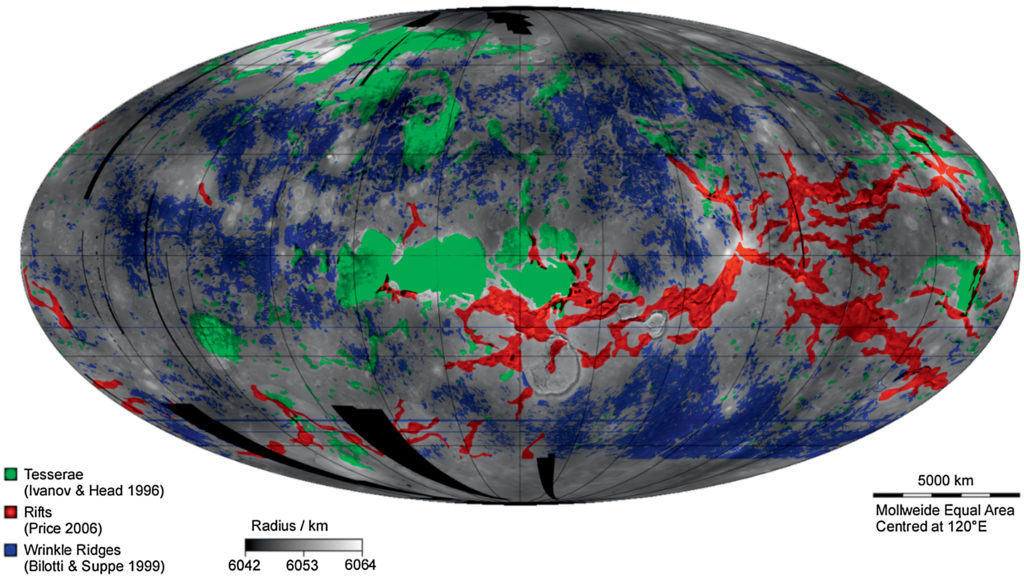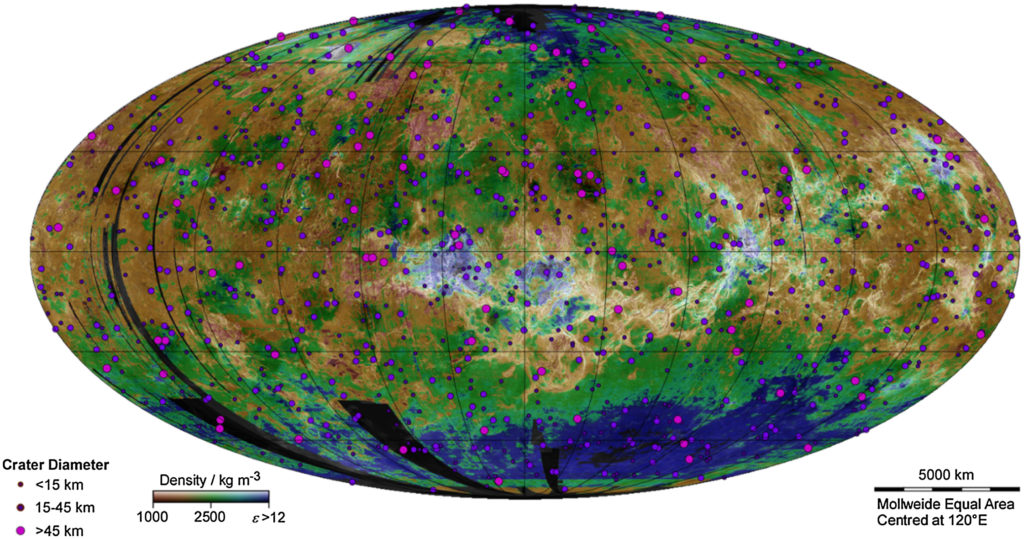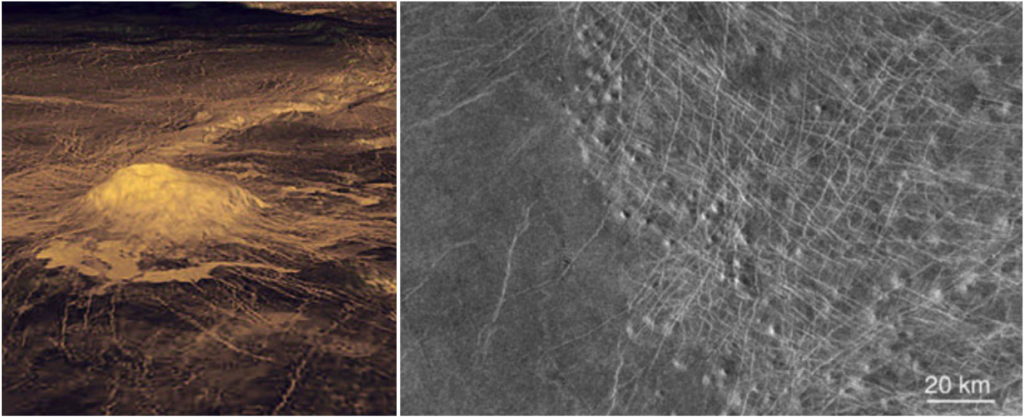Science with EnVision - EnVision
Science with EnVision
EnVision overall science goals
EnVision was selected as ESA's Cosmic Vision M5 mission in 2021, and the mission adoption is scheduled for January/February 2024. It is an orbiter mission, aiming at determining the nature and current state of Venus’ geological evolution and its relationship with the atmosphere, to understand how and why Venus and Earth evolved so differently. EnVision’s overall science goals are:
- to characterise the sequence of events that generated the regional and global surface features of Venus, and characterise the geodynamics framework that controls the release of internal heat over Venus history;
- to search for ongoing geological processes and determine whether the planet is active in the present era;
-
to characterise the interaction between the planet and its atmosphere both at present and through time, to better assess whether Venus could once have had liquid water on its surface.
EnVision will deliver new insights into the planet's geological history through complementary imagery, polarimetry, radiometry and spectroscopy of the surface coupled with subsurface sounding and gravity mapping. It will search for thermal, morphological, and gaseous signs of volcanic and other geological activity, and it will trace the transport and cycling of key volatile species from their sources and sinks at the surface through the clouds up to the mesosphere.
Venus interior
To a first approximation, Venus’ interior is generally assumed to be “Earth-like”, based on its similar bulk composition and radius. However, modelling shows a large uncertainty on the size of the core and on the mantle composition. Furthermore, its moment of inertia - one of the most powerful way to constrain the first order radial structure of a planet - is not known with a sufficient accuracy. Similarly, the tidal Love number, estimated from Doppler tracking of Magellan and Pioneer Venus Orbiter spacecraft data, is not sufficiently accurate to constrain the size and state of the Venus core. The latter are key parameters to better understand Venus’ thermal evolution.
Magellan gravity data are consistent with an organized pattern of mantle convection, broadly similar to Earth, but lack the resolution necessary to understand its connection with geological-scale features such as individual coronae or mountain belts. Therefore, higher spatial resolution gravity data is needed to better constrain the crustal and lithospheric structure variations, which is essential to understand the geodynamic evolution of the planet. EnVision will provide this.
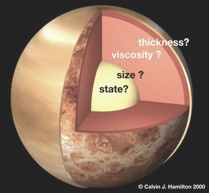
Sketch of the interior of Venus, showing the main open questions on its structure. Copyright Calvin J. Hamilton 2000.
Venus plains
About 70 % of Venus topography lies near the global mean average, consisting variously of smooth, gently undulating or ridged terrain. There is a huge variety of features found on these plains – from volcanic features (see-sides domes etc), tectonic features (e.g. wrinkle ridges etc), evidence of flows (canali), aeolian features (dune fields, parabolae). Are canali or other specific magmatic features confined to a past regime or still active today? Is there a correlation between mesospheric SO2 concentration and volcanic activity? Are crater floors effusively infilled and buried from below? Were the plains formed from a few massive outpourings in a short period of time or from many thousands of small flows over their entire history? Or were they formed, or modified, in an entirely different way?
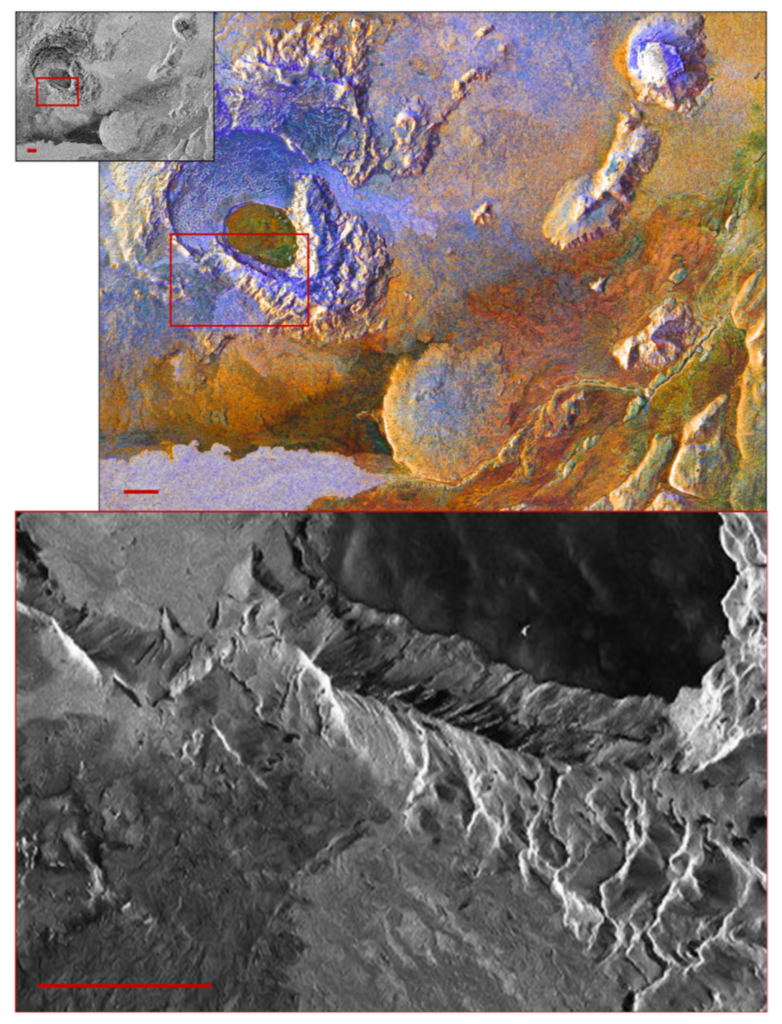
Venus tectonic features
The surface of Venus is not organised into large plates like Earth’s oceans but it is partitioned into areas of low strain bounded by narrow margins of high strain, analogous to continental basins and microplates. Are these regions actively created and destroyed, like Earth’s oceans, or simply mobilised locally? What is the significance of the global network of elevated rift systems, similar in extent to mid-ocean ridges but very different in appearance? Unique to Venus are coronae, quasi-circular tectonic features, typically 100–500 km across, with a range of associated volcanic features. Are coronae the surface expression of plumes or magmatic intrusions? What role do they play in global tectonic and volcanic change?
Venus impact craters
Impact craters give absolute age of some surfaces, but too few can be seen to allow dating constraints on different geological units. On Venus, the spatial distribution of impact craters cannot be distinguished from a completely spatially random population. This indicates a relatively young surface (less than 600-800Ma). There are open questions about buried features and the nature of volcanic resurfacing. It could have occurred steadily or experienced catastrophic episodes. A debate still exists between “directional” and “non-directional” models. Mapping impact craters and their geological alteration processes will allow to construct a global chronology of the surface that is currently missing.
Venus tesserae highlands
Representing about 10 % of the Venus surface, tesserae may represent the oldest terrain on Venus. The processes which have shaped them are unknown. They have never been visited by any lander, so their composition is unknown. They might be either felsic (formed in a water-rich environment) or mafic rock types. Detailed morphology and their tectonic features, coupled with characterisation of surface emissivity and subsurface features, will provide an extensive investigation of these regions.
Densely fractured plains (image right, cut by NNW set of faults) embaying tessera (bottom, cut by multiple sets of faults) indicating that emplacement of the material of the densely fractured plains postdated formation of tessera terrain. Both densely fractured plains and tessera are embayed by even younger regional plains (dark areas). A steep-sided volcanic dome is seen in the upper left. Its age relations with the surrounding regional plains are not known. Portion of Magellan image centered at 46N, 360E. After Basilevsky and McGill (2007), Surface evolution of Venus, in Exploring Venus as a Terrestrial Planet, Geophysical Monograph Series 176, edited by L. W. Esposito, E. R. Stofan and T. E. Cravens, pp. 23-43, American Geophysical Union, Washington, DC.
Venus volcanic rises
Given its similar size and bulk composition as Earth, Venus is expected to be volcanically and tectonically active today (unlike Mars, which, being only a tenth of Earth’s mass, has lost more of its internal heat). Steep slopes and landslides are common on Venus’ surface, implying active uplift, but existing data provide no constraint on current rates of tectonic activity. Comparisons of gravity mapping and topography have revealed regions at high elevation, explained by their location on top of magmatic upwelling areas. Sites of potential volcanism identified in Venus Express data are located in regions where volcanic activity is particularly likely to occur. Therefore, the observation and characterisation of these regions are of high priority for Envision.
Left: Idunn Mons (46 S; 146 W) in Imdr Regio, with its steep-sided dome at the summit, as well as lava flows extending in the surrounding plain, is characterised with high emissivity measurements pointing to recent volcanism. Right: a volcanic shield field inside a corona structure, surrounded by a set of younger lava plains.
Venus atmospheric variability
Investigations over the past decades have shown that the atmosphere of Venus is much more variable in terms of dynamics, cloud properties, and trace gas composition than initially thought. Monitoring of the spatial and temporal variability of the atmosphere and surface can help to determine the influence of the planet's internal and surface processes on the present-day atmosphere. EnVision will map tropospheric gases below the clouds, and in particular species potentially related to volcanic activity such as CO, OCS, H2O (separately from its deuterated isotope, HDO) and SO2. The lower cloud layers will be investigated by measuring gas and liquid H2SO4 content. The upper cloud layers, which contain an UV absorber of yet unknown composition, will also be monitored, along with highly variable trace gas species such as SO2, SO, H2O, HDO, OCS and CO.
Simulated advection of a volatile gas plume emitted from Imdr Regio. Black contours represent topography. Colours show excess water vapour (in arbitrary units) after 72 hours of outgassing, at 10 km altitude (left) and 35 km altitude (right). (Wilson & Lefèvre, EnVision Science Conference, Feb. 2020, CNES, Paris 2020).
EnVision Science investigations
-
Use SAR imaging and ranging techniques from a polar orbit to characterise structural, and geomorphic evidence of multi-scale processes that shaped the geological history of Venus,
-
Look for thermal signature of volcanic activity at the surface. This can be done through observations either in near-IR spectral window regions and in microwave wavelengths.
-
Perform spectrometry of different surface units is critical for understanding their composition. Although the optically thick Venus atmosphere precludes this at most wavelengths, there are five spectral windows between 0.8 and 1.2 μm at which thermal emission from the surface escapes to space. Surface emissivity at these wavelengths encodes crucial information about mineralogical characteristics like Fe content. Emissivity mapping using these wavelengths, helps to test theories of surface composition, for example about whether the tessera highlands are composed of felsic materials akin to Earth’s granitic continental crust.
-
Search for spatial and temporal variability of gases related to volcanic activity, such as H2O, SO2, CO or OCS, and their colocation with potentially active geological regions or features.
-
Investigate sensitivity to unit boundaries beneath the surface, and ability to detect buried structures, would significantly enhance the reconstruction of stratigraphy and thus in the reconstruction of the geological record. Subsurface sounding can enable measurement of the depth of volcanic flows and therefore the volume of volcanic effusions; of buried unit boundaries beneath volcanic plains, such as mapping of the edges of tessera regions; and could reveal unexpected features such as buried impact craters
-
Use the radio-science gravity experiment to better constrain the internal structure of Venus (size and core state, mantle composition, litosphere and crustal thickness average and variability).
- Removed a total of (9) style text-align:center;
- Removed a total of (5) style margin:0;








































 Sign in
Sign in
 Science & Technology
Science & Technology
